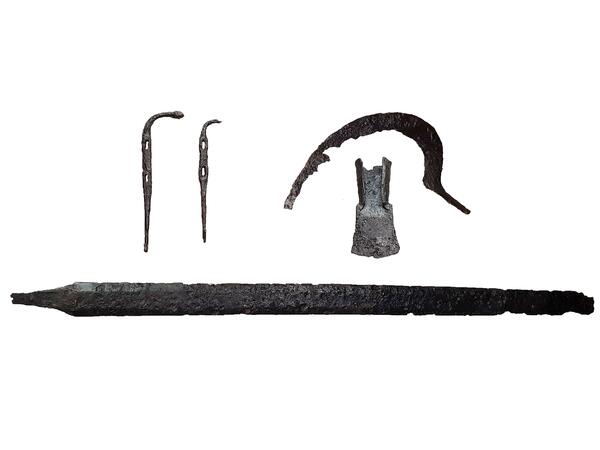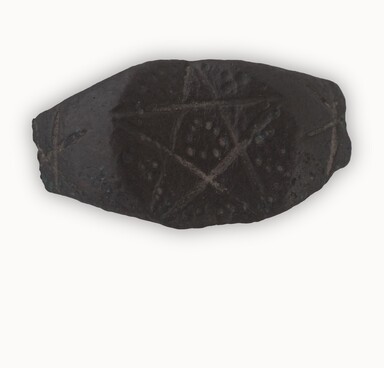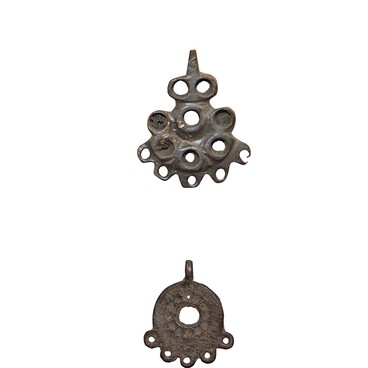In 2014, the Kursk State Regional Museum of Archaeology received a group of items that were accidentally found in Khomutovsky district of Kursk region on the right bank of the Seim River, near the southwestern end of the lake, located between the Svapa and Nestun rivers. The collection was named after a nearby settlement (the farm of Zhilishche), which is located on the territory of the neighboring Lgovsky district. Discovered among the roots of a tree at a depth of about 25 cm, the hoard consisted of five iron items: a sword, two cheekpieces of a bridle (cheekpieces are a pair of vertical rods, part of the ancient bridle set), a hoe and a sickle.
According to the finder, the sword covered the hoe and the cheekpieces, and the sickle was located at the top of the blade, without coming into contact with it. The hoard has a number of distinctive features: the sword is not completely preserved, the upper part of the hilt and the end of the blade are broken off. The custom of breaking off the end of the swords placed in the grave is noted by researchers in the early medieval burials of eastern Kazakhstan and Siberia. According to the research of the Russian historian and archaeologist Yuly Sergeevich Khudyakov, the ritual deformation of cutting and stabbing weapons before laying them in the grave as an accompanying inventory was common in these territories in the 6th–9th centuries. Such a ritual dates back to the Tashtyk era (the Iron Age archaeological culture of southern Siberia from the 2nd century BC to the 5th century AD). Besides, the sickle and the hoe show traces of deformation from exposure to high temperature.
The analysis of the items suggests that the Zhilishche hoard is in fact part of a burial or memorial complex of the late 7th — the first half of the 8th century, abandoned by people who were culturally and possibly ethnically related to the Turks or other tribes of the Western Turkic Khaganate, partially included in the Khazar Khaganate. Thus, the Zhilishche hoard is an evidence of the presence of the Saltovo or pre-Saltovo tradition in the western part of the modern Kursk region at the end of the 7th — the first half of the 8th century (the Saltovo culture is an archeological culture of the Iron Age in southern Russia and the southeast of Ukraine, dated from the middle of the 8th — the early 10th century). The hoard may also mark one line of migration of representatives of nomadic and semi-nomadic tribes, who participated in the creation of the Khazar Khaganate, in the northeast of the Dnieper left bank.
According to the finder, the sword covered the hoe and the cheekpieces, and the sickle was located at the top of the blade, without coming into contact with it. The hoard has a number of distinctive features: the sword is not completely preserved, the upper part of the hilt and the end of the blade are broken off. The custom of breaking off the end of the swords placed in the grave is noted by researchers in the early medieval burials of eastern Kazakhstan and Siberia. According to the research of the Russian historian and archaeologist Yuly Sergeevich Khudyakov, the ritual deformation of cutting and stabbing weapons before laying them in the grave as an accompanying inventory was common in these territories in the 6th–9th centuries. Such a ritual dates back to the Tashtyk era (the Iron Age archaeological culture of southern Siberia from the 2nd century BC to the 5th century AD). Besides, the sickle and the hoe show traces of deformation from exposure to high temperature.
The analysis of the items suggests that the Zhilishche hoard is in fact part of a burial or memorial complex of the late 7th — the first half of the 8th century, abandoned by people who were culturally and possibly ethnically related to the Turks or other tribes of the Western Turkic Khaganate, partially included in the Khazar Khaganate. Thus, the Zhilishche hoard is an evidence of the presence of the Saltovo or pre-Saltovo tradition in the western part of the modern Kursk region at the end of the 7th — the first half of the 8th century (the Saltovo culture is an archeological culture of the Iron Age in southern Russia and the southeast of Ukraine, dated from the middle of the 8th — the early 10th century). The hoard may also mark one line of migration of representatives of nomadic and semi-nomadic tribes, who participated in the creation of the Khazar Khaganate, in the northeast of the Dnieper left bank.



